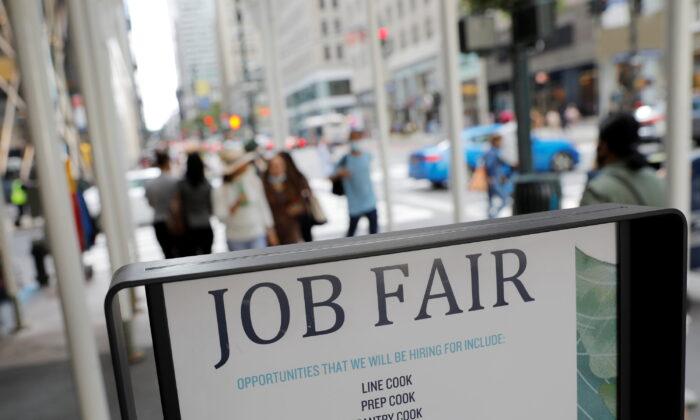U.S. job openings, a measure of labor demand, dropped to their lowest level in nearly two years in February, a potential sign that tight labor market conditions are finally easing.
This could be good news for the Federal Reserve’s aggressive interest rate policy, as it considers whether to pause its cycle of rate hikes.
The Fed historically watches the JOLTS report, as it tries to gauge labor market tightness and keep inflation under control.
The central bank had responded to the inflation crisis and the tight labor market by raising interest rates to their highest level in decades.
Job Vacancies Still Remain High
Despite the larger-than-expected decline in job vacancies, there are still 1.7 job openings for every unemployed person in February, down from 1.9 in January. These are figures the central bank officials closely monitor.This means that the labor market still has a way to go, as demand for employees still far outpaces the available supply, but the gap is beginning to shrink.
The report showed 9.9 million job openings in February, the lowest level since May 2021, a decline from the downwardly revised 10.6 million openings reported in the previous month.
Before the pandemic in early 2020, the highest on record was 7.6 million.
There was a 632,000 decline in job openings in February out of the total 1.3 million in the first two months of the year, while the job openings rate fell to 6 from 6.4 percent in January.
Economists surveyed by Refinitiv had expected openings to fall to 10.4 million.
The downward slide in job openings occurred before the recent bank crisis in March, which led to tighter credit conditions and sparked fears of widespread job losses.
The decline in openings was largely felt in the professional and business services sector, where job openings fell 278,000.
There were also 150,000 fewer open positions in the healthcare and social assistance industry, while vacancies in the transportation, warehousing, and utilities sector fell by 145,000.
The construction industry had seen a larger worker need, with job openings increasing by 129,000.
Meanwhile, there were 38,000 vacancies in the arts, entertainment, and recreation sectors.

The drop in job vacancies was regionally concentrated in the Midwest, South, and West, with the Northeast witnessing a moderate decline.
Small and medium-sized businesses, which have been the movers of job growth, accounted for most of the declines, as companies with 1,000 workers or more reporting a small reduction in job openings.
Americans Continue to Leave Jobs For Better Opportunities
The quits rate, which is viewed as a measure of labor market confidence, rose to 2.6 percent from 2.5 percent of the workforce in January, as workers still feel secure enough to leave their jobs and find employment elsewhere.On the other hand, it is still below the 2.9 to 3.0 percent range from late 2021 and early 2022, when the frequency of workers switching jobs was at its peak.
Layoffs fell 215,000 to 1.5 million in February, mostly in small and medium-sized businesses, while the layoffs rate fell to 1 percent from 1.1 percent in January.
In the accommodation and food services industry, 93,000 workers quit, while wholesale trade reported 31,000 resignations.
About 18,000 educational services workers quit in February, but there were fewer quits in the finance and insurance industry, where resignations fell 39,000.
The professional and business services sector also saw an additional 115,000 resignations.
As the level of job openings declined, the number of workers voluntarily quitting their positions surged 146,000 to 4.0 million, mostly in small businesses.
“Worker power in the market remains high with more than four million quits during February,” Ayers said.
“Many employees continue to find higher pay and better advancement opportunities at other firms, a trend enhanced by widespread remote work options. This continues to drive wages higher and poses a further inflation risk for the economy.”
Roughly 49 percent of those who switched jobs saw their real hourly wages increase faster than inflation last year, compared with just 42 percent of workers who stayed at their same job, according to recent Atlanta Fed data.
New hires fell to 6.2 million in February from 6.3 million, lowering the hires rate to 4 from 4.1 percent for the month.
Labor reported a solid 311,000 new jobs in February, after factoring in both hires and layoffs but declined from 504,000 in January.

Fed Policies May Spur More Job Losses
The Fed early last month raised its borrowing rate by a quarter of a percentage point, but policymakers have indicated they may pause further rate hikes in the aftermath of the Silicon Valley Bank collapse and its effect on lending.Central bank officials have carried out nine straight rate hikes and have indicated that a tenth increase is possible in May.
The fed policy rate has been raised 475 basis points since March 2022 from the near-zero level to the current 4.75 to 5.00 percent range.
A final 25 percent hike would follow the Fed’s plan to raise its key interest rate to 5 to 5.25 percent as it monitors the turmoil in the financial markets.Some economists are concerned that tightening lending standards could cause a sharp weakening in the labor market.
“The labor market was starting to lose steam even before the banking crisis hit the economy in March and this sets up a dangerous situation where tighter credit conditions could prompt actual layoffs in the months ahead as corporations struggle to get costs under control,” Christopher Rupkey, chief economist at FWDBONDS in New York, told Reuters.
The employment report for March will be released on April 7 and is expected to shed more detail on the health of the labor market.





